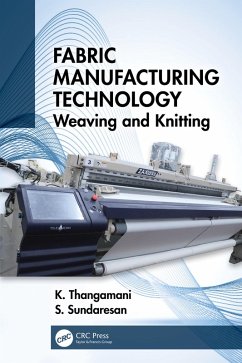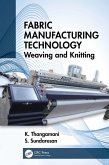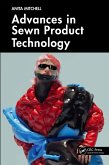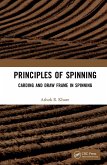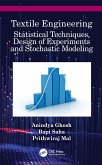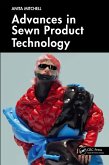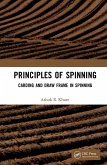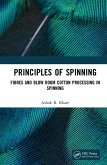47,95 €
47,95 €
inkl. MwSt.
Sofort per Download lieferbar

24 °P sammeln
47,95 €
Als Download kaufen

47,95 €
inkl. MwSt.
Sofort per Download lieferbar

24 °P sammeln
Jetzt verschenken
Alle Infos zum eBook verschenken
47,95 €
inkl. MwSt.
Sofort per Download lieferbar
Alle Infos zum eBook verschenken

24 °P sammeln
- Format: ePub
- Merkliste
- Auf die Merkliste
- Bewerten Bewerten
- Teilen
- Produkt teilen
- Produkterinnerung
- Produkterinnerung

Bitte loggen Sie sich zunächst in Ihr Kundenkonto ein oder registrieren Sie sich bei
bücher.de, um das eBook-Abo tolino select nutzen zu können.
Hier können Sie sich einloggen
Hier können Sie sich einloggen
Sie sind bereits eingeloggt. Klicken Sie auf 2. tolino select Abo, um fortzufahren.

Bitte loggen Sie sich zunächst in Ihr Kundenkonto ein oder registrieren Sie sich bei bücher.de, um das eBook-Abo tolino select nutzen zu können.
This book gives reader a brief idea about the principles involved in fabric formation methods, namely weaving and knitting covering various mechanisms involved starting from primitive handlooms to the latest shuttleless loom and from hand knitting to ultra-modern electronic knitting machines.
- Geräte: eReader
- ohne Kopierschutz
- eBook Hilfe
- Größe: 12.35MB
Andere Kunden interessierten sich auch für
![Fabric Manufacturing Technology (eBook, PDF) Fabric Manufacturing Technology (eBook, PDF)]() K. ThangamaniFabric Manufacturing Technology (eBook, PDF)47,95 €
K. ThangamaniFabric Manufacturing Technology (eBook, PDF)47,95 €![Advances in Sewn Product Technology (eBook, ePUB) Advances in Sewn Product Technology (eBook, ePUB)]() Anita MitchellAdvances in Sewn Product Technology (eBook, ePUB)88,95 €
Anita MitchellAdvances in Sewn Product Technology (eBook, ePUB)88,95 €![Principles of Spinning (eBook, ePUB) Principles of Spinning (eBook, ePUB)]() Ashok R KharePrinciples of Spinning (eBook, ePUB)51,95 €
Ashok R KharePrinciples of Spinning (eBook, ePUB)51,95 €![Textile Engineering (eBook, ePUB) Textile Engineering (eBook, ePUB)]() Anindya GhoshTextile Engineering (eBook, ePUB)62,95 €
Anindya GhoshTextile Engineering (eBook, ePUB)62,95 €![Advances in Sewn Product Technology (eBook, PDF) Advances in Sewn Product Technology (eBook, PDF)]() Anita MitchellAdvances in Sewn Product Technology (eBook, PDF)88,95 €
Anita MitchellAdvances in Sewn Product Technology (eBook, PDF)88,95 €![Principles of Spinning (eBook, PDF) Principles of Spinning (eBook, PDF)]() Ashok R KharePrinciples of Spinning (eBook, PDF)51,95 €
Ashok R KharePrinciples of Spinning (eBook, PDF)51,95 €![Principles of Spinning (eBook, ePUB) Principles of Spinning (eBook, ePUB)]() Ashok R. KharePrinciples of Spinning (eBook, ePUB)50,95 €
Ashok R. KharePrinciples of Spinning (eBook, ePUB)50,95 €-
-
-
This book gives reader a brief idea about the principles involved in fabric formation methods, namely weaving and knitting covering various mechanisms involved starting from primitive handlooms to the latest shuttleless loom and from hand knitting to ultra-modern electronic knitting machines.
Dieser Download kann aus rechtlichen Gründen nur mit Rechnungsadresse in A, B, BG, CY, CZ, D, DK, EW, E, FIN, F, GR, HR, H, IRL, I, LT, L, LR, M, NL, PL, P, R, S, SLO, SK ausgeliefert werden.
Produktdetails
- Produktdetails
- Verlag: Taylor & Francis
- Seitenzahl: 205
- Erscheinungstermin: 4. April 2022
- Englisch
- ISBN-13: 9781000553130
- Artikelnr.: 63704987
- Verlag: Taylor & Francis
- Seitenzahl: 205
- Erscheinungstermin: 4. April 2022
- Englisch
- ISBN-13: 9781000553130
- Artikelnr.: 63704987
- Herstellerkennzeichnung Die Herstellerinformationen sind derzeit nicht verfügbar.
Dr. K. Thangamani has completed his B. Tech Degree in 1981 at PSG college of Technology and started his carrier as Trainee Engineer at Textool company Ltd. From1981 he worked for four years at National Textile Corporation Ltd., Bangalore first as Management Trainee and then as Asst. Manager Technical. 1985 he joined Tamarai Mills Ltd Coimbatore as Asst. Spinning Master . From 1988 to 1990 he was with PSG Polytechnic in research projects. He completed his M.Tech from Bharathiar University in 1993. In 1990-97 he joined PSG College of Technology as Project officer in UNDP assisted National Jute Development Project and conducted more than fifty training programs and more than ten seminars /conferences throughout South India for promotion of diversified Jute products. The Jute Shopping bags were introduced at that time. He was with NIFT TEA knitwear fashion Institute, Tirupur as Asst. Director for a brief period
Since 1998, he is with Kumaraguru College of Technology, Coimbatore as faculty of Textile Technology and at present he is Professor of Textile Technology. His area of Interest are Knitting Technology, Nonwoven, Composites and Fabric manufacture. He obtained his PhD in Textile Technology in 2007 from Bharathiar University and is a recognized supervisor for PhD scholars in Anna University, Chennai. Under his supervision four scholars has obtained PhD from Anna University. one more scholar is waiting for the results.
He was the Executive committee member of the Institution of Engineers (India) Tamil Nadu state centre of for eight years from 2002. He was the organizing secretary for the International Conference on "Advancements in Specialty Textiles and their Applications in Material Engineering and Medical Sciences " organised jointly with Technical University of Liberec ,Czech Republic at Kumaraguru college of Technology, Coimbatore on 29th -30th ,April 2014 .He was the joint organizing secretary for the International Conference on "Waste Water Management" organized but Departs of Textile Technology, Bio Technology and Civil Engineering jointly with Tel AVIV university Israel and Technical University of Liberec ,Czech at Kumaraguru college of Technology, Coimbatore from August b17th to 19th 2017.
He is one of the editor for the book Waste water management which contains selected articles from the International Conference on "Waste Water Management" conducted in the year 2017 in Kumaraguru college of Technology
Dr. S Sundaresan has completed his B.Tech, M.Tech and PhD in Textile Technology and MBA in Business Administration . He has worked in Textile Industry as supervisor for 10 years. He has more than 15 years of teaching experience and at present he is working as Assistant Professor (Senior Grade) at Department of Textile Technology, Kumaraguru College of Technology, Coimbatore. He has published more than 20 papers in leading journals. He has co-authored a book titled: Home Furnishing Wood head publishing (India). He has undertaken many consultancies works in industry.
Since 1998, he is with Kumaraguru College of Technology, Coimbatore as faculty of Textile Technology and at present he is Professor of Textile Technology. His area of Interest are Knitting Technology, Nonwoven, Composites and Fabric manufacture. He obtained his PhD in Textile Technology in 2007 from Bharathiar University and is a recognized supervisor for PhD scholars in Anna University, Chennai. Under his supervision four scholars has obtained PhD from Anna University. one more scholar is waiting for the results.
He was the Executive committee member of the Institution of Engineers (India) Tamil Nadu state centre of for eight years from 2002. He was the organizing secretary for the International Conference on "Advancements in Specialty Textiles and their Applications in Material Engineering and Medical Sciences " organised jointly with Technical University of Liberec ,Czech Republic at Kumaraguru college of Technology, Coimbatore on 29th -30th ,April 2014 .He was the joint organizing secretary for the International Conference on "Waste Water Management" organized but Departs of Textile Technology, Bio Technology and Civil Engineering jointly with Tel AVIV university Israel and Technical University of Liberec ,Czech at Kumaraguru college of Technology, Coimbatore from August b17th to 19th 2017.
He is one of the editor for the book Waste water management which contains selected articles from the International Conference on "Waste Water Management" conducted in the year 2017 in Kumaraguru college of Technology
Dr. S Sundaresan has completed his B.Tech, M.Tech and PhD in Textile Technology and MBA in Business Administration . He has worked in Textile Industry as supervisor for 10 years. He has more than 15 years of teaching experience and at present he is working as Assistant Professor (Senior Grade) at Department of Textile Technology, Kumaraguru College of Technology, Coimbatore. He has published more than 20 papers in leading journals. He has co-authored a book titled: Home Furnishing Wood head publishing (India). He has undertaken many consultancies works in industry.
1: Introduction. 2: Fabric formation methods. 3: Yarn Preparation for weaving. 4: Weaving -Basic Mechanisms. 5: Shedding. 6: Shuttle Weaving. 7: Shuttle less Weaving. 8: Projectile weaving. 9: Rapier weaving. 10: Air Jet weaving. 11: Water Jet weaving. 12: Multiphase weaving. 13: Techno-Economics of Shuttle less looms. 14: Global weaving industry. 15: Fundamentals of Knitting. 16: Knitting needles. 17: Principles of weft knitting.18: Basic structures of weft knitting. 19: Principles of weft knitting design. 20: Patterning and needle selection. 21: Knitted fabric geometry. 22: Flat knitting. 23: Basics of Warp knitting. 24: Warp knitting machines. 25: Warp knitted structures. 26: Non-woven- Batt preparation methods. 27: Non-woven- Bonding techniques.
1: Introduction. 2: Fabric formation methods. 3: Yarn Preparation for
weaving. 4: Weaving -Basic Mechanisms. 5: Shedding. 6: Shuttle Weaving. 7:
Shuttle less Weaving. 8: Projectile weaving. 9: Rapier weaving. 10: Air Jet
weaving. 11: Water Jet weaving. 12: Multiphase weaving. 13:
Techno-Economics of Shuttle less looms. 14: Global weaving industry. 15:
Fundamentals of Knitting. 16: Knitting needles. 17: Principles of weft
knitting.18: Basic structures of weft knitting. 19: Principles of weft
knitting design. 20: Patterning and needle selection. 21: Knitted fabric
geometry. 22: Flat knitting. 23: Basics of Warp knitting. 24: Warp knitting
machines. 25: Warp knitted structures. 26: Non-woven- Batt preparation
methods. 27: Non-woven- Bonding techniques.
weaving. 4: Weaving -Basic Mechanisms. 5: Shedding. 6: Shuttle Weaving. 7:
Shuttle less Weaving. 8: Projectile weaving. 9: Rapier weaving. 10: Air Jet
weaving. 11: Water Jet weaving. 12: Multiphase weaving. 13:
Techno-Economics of Shuttle less looms. 14: Global weaving industry. 15:
Fundamentals of Knitting. 16: Knitting needles. 17: Principles of weft
knitting.18: Basic structures of weft knitting. 19: Principles of weft
knitting design. 20: Patterning and needle selection. 21: Knitted fabric
geometry. 22: Flat knitting. 23: Basics of Warp knitting. 24: Warp knitting
machines. 25: Warp knitted structures. 26: Non-woven- Batt preparation
methods. 27: Non-woven- Bonding techniques.
1: Introduction. 2: Fabric formation methods. 3: Yarn Preparation for weaving. 4: Weaving -Basic Mechanisms. 5: Shedding. 6: Shuttle Weaving. 7: Shuttle less Weaving. 8: Projectile weaving. 9: Rapier weaving. 10: Air Jet weaving. 11: Water Jet weaving. 12: Multiphase weaving. 13: Techno-Economics of Shuttle less looms. 14: Global weaving industry. 15: Fundamentals of Knitting. 16: Knitting needles. 17: Principles of weft knitting.18: Basic structures of weft knitting. 19: Principles of weft knitting design. 20: Patterning and needle selection. 21: Knitted fabric geometry. 22: Flat knitting. 23: Basics of Warp knitting. 24: Warp knitting machines. 25: Warp knitted structures. 26: Non-woven- Batt preparation methods. 27: Non-woven- Bonding techniques.
1: Introduction. 2: Fabric formation methods. 3: Yarn Preparation for
weaving. 4: Weaving -Basic Mechanisms. 5: Shedding. 6: Shuttle Weaving. 7:
Shuttle less Weaving. 8: Projectile weaving. 9: Rapier weaving. 10: Air Jet
weaving. 11: Water Jet weaving. 12: Multiphase weaving. 13:
Techno-Economics of Shuttle less looms. 14: Global weaving industry. 15:
Fundamentals of Knitting. 16: Knitting needles. 17: Principles of weft
knitting.18: Basic structures of weft knitting. 19: Principles of weft
knitting design. 20: Patterning and needle selection. 21: Knitted fabric
geometry. 22: Flat knitting. 23: Basics of Warp knitting. 24: Warp knitting
machines. 25: Warp knitted structures. 26: Non-woven- Batt preparation
methods. 27: Non-woven- Bonding techniques.
weaving. 4: Weaving -Basic Mechanisms. 5: Shedding. 6: Shuttle Weaving. 7:
Shuttle less Weaving. 8: Projectile weaving. 9: Rapier weaving. 10: Air Jet
weaving. 11: Water Jet weaving. 12: Multiphase weaving. 13:
Techno-Economics of Shuttle less looms. 14: Global weaving industry. 15:
Fundamentals of Knitting. 16: Knitting needles. 17: Principles of weft
knitting.18: Basic structures of weft knitting. 19: Principles of weft
knitting design. 20: Patterning and needle selection. 21: Knitted fabric
geometry. 22: Flat knitting. 23: Basics of Warp knitting. 24: Warp knitting
machines. 25: Warp knitted structures. 26: Non-woven- Batt preparation
methods. 27: Non-woven- Bonding techniques.
